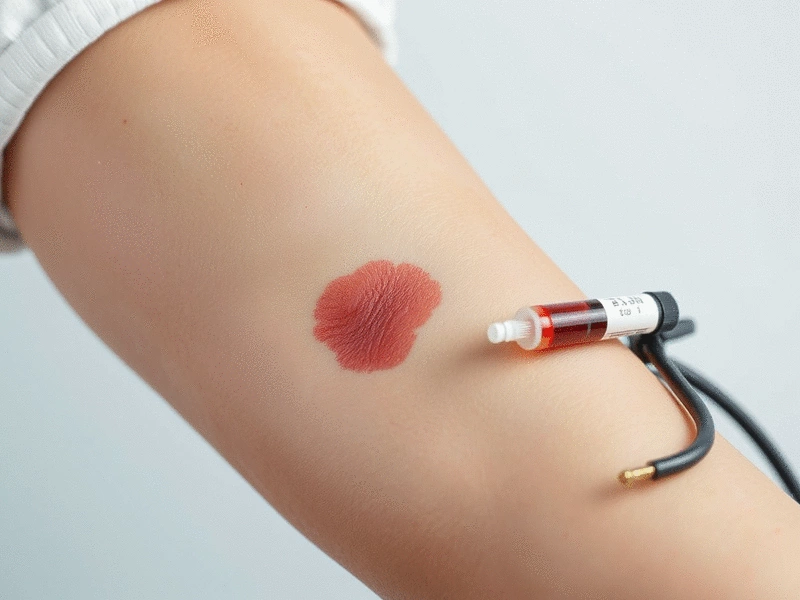Leukemia's Impact on Blood Clotting

Have you ever wondered how a low platelet count can affect daily life for leukemia patients? Understanding the impact of symptoms like bruising can empower you or a loved one to seek timely medical care. This knowledge is crucial in navigating the complexities of a leukemia diagnosis.
What You Will Learn
- Bruising in leukemia is primarily caused by thrombocytopenia, a condition characterized by low platelet counts.
- Platelets are essential for blood clotting; when their production is disrupted, patients become more prone to bruising and bleeding.
- Key factors affecting platelet counts include bone marrow infiltration by leukemia cells, increased platelet destruction, and the effects of chemotherapy.
- Recognizing emergency symptoms associated with bleeding, such as unexplained bruising and prolonged bleeding, is vital for timely medical intervention.
The Impact of Leukemia on Blood Components and Related Symptoms
This visual illustrates how leukemia affects the production of essential blood components in the bone marrow, leading to various physical symptoms.
Bone Marrow Infiltration: Disrupted Production
Leukemia cells crowd out normal bone marrow cells, severely limiting the production of healthy blood components.
Healthy Marrow
Leukemic Marrow
Leukemia's Effect on Blood Cell Production
Platelets: Reduced count → Bruising/Bleeding
Red Blood Cells: Shortage → Anemia (Fatigue)
White Blood Cells: Deficiency → Increased Infections
Each cell type is critical for distinct bodily functions.
Platelets: Mending vs. Vulnerable
Platelets act as 'plugs' to stop bleeding. Leukemia compromises this essential clotting function.
Healthy Clotting
Weak Clotting
Key Emergency Bleeding Symptoms
- ● Unexplained/Excessive Bruising
- ● Frequent Nosebleeds (hard to stop)
- ● Blood in Urine or Stool
- ● Severe Headaches/Vision Changes
Prompt medical attention is crucial for these signs.
Understanding the Connection Between Leukemia and Bruising
When it comes to leukemia, many symptoms can arise, and one of the more noticeable ones is bruising. This occurs due to a specific condition known as thrombocytopenia, which is the medical term for a low platelet count. Platelets are crucial for blood clotting, and when their numbers drop, even minor bumps can lead to significant bruising. Understanding this relationship can help patients and their families navigate the complexities of a leukemia diagnosis.
As a hematologist, I've seen firsthand how unsettling it can be for patients when they notice unexplained bruising. It often raises questions and concerns, which is completely understandable. By shedding light on what causes these symptoms, we can replace fear with knowledge and empower those affected.

What Causes Bruising and Bleeding in Leukemia?
The primary cause of bruising and bleeding in leukemia patients is a reduced number of platelets. Platelets are tiny blood cells responsible for helping your blood clot. When leukemia affects the bone marrow, it can disrupt the production of these essential cells, leading to increased susceptibility to bruising. Here are some factors that contribute to this issue:
- Bone marrow infiltration: Leukemia cells can crowd out normal cells, limiting platelet production. For a deeper understanding of how bone marrow infiltration impacts blood cell production, you can refer to this study on bone marrow abnormalities in leukemia.
- Increased destruction: The body may mistakenly destroy platelets at a higher rate.
- Chemotherapy effects: Treatments may also impact platelet counts, leading to further bruising.
Understanding these causes is vital for managing symptoms and seeking appropriate interventions. It's essential to stay vigilant and communicate any concerns with your healthcare team, so you receive the support you need.
The Role of Platelets in Blood Clotting
Platelets play a vital role in the body’s ability to stop bleeding. They act like a plug, sealing damaged blood vessels and preventing excessive blood loss. In a healthy individual, when you experience an injury, platelets rush to the site to form a clot. However, in leukemia patients, the dysfunction of platelets can lead to increased bleeding risks, even from minor injuries.
To illustrate, think of platelets as tiny workers mending a fence. If there aren't enough of them, or if they're not functioning properly, the fence remains vulnerable to the elements—in this case, bleeding occurs more easily. Therefore, understanding how vital platelets are can help you appreciate the challenges faced by those with leukemia.
Bone Marrow's Role in Blood Cell Production
The bone marrow is a central player in blood cell production, generating red blood cells, white blood cells, and platelets. In leukemia, this process can become severely disrupted. For instance, an influx of cancerous cells can overwhelm the marrow and limit its ability to produce enough healthy blood cells. Here’s how leukemia can affect each type of blood cell:
- Platelets: As previously discussed, low platelet counts lead to bruising and bleeding.
- Red blood cells: A shortage can cause anemia, leading to fatigue and weakness.
- White blood cells: These are crucial for fighting infections; their deficiency increases susceptibility to illness. For more information on the impact of leukemia on the immune system, consult this article on leukemia and immune dysfunction.
Understanding the role of bone marrow in these processes is essential. It underscores the complexity of leukemia and the importance of regular monitoring and communication with healthcare providers. Knowledge is a powerful tool, and at What Is Leukemia, we strive to help you harness that knowledge throughout your journey.
Types of Leukemia and Their Symptoms Related to Bruising
As we explore the various types of leukemia, it’s crucial to understand how each one can manifest differently, especially concerning bruising and bleeding. Each type can present unique challenges, with symptoms that may include bruising as a significant concern. Let’s take a closer look at the common forms of leukemia and their specific symptoms.
We Want to Hear From You!
What has your experience been with recognizing symptoms of bruising or bleeding? Share your thoughts or any questions you may have below:
Moving Forward: Understanding Your Symptoms and When to Seek Help
When navigating the complexities of leukemia, it’s crucial to be aware of your body and its signals. Recognizing the symptoms associated with bleeding can empower you to seek help promptly. At What Is Leukemia, I encourage every patient to stay vigilant and informed, as this can significantly impact your treatment journey.
Some symptoms may seem minor, but they can signal serious complications. Understanding these signs can be the first step toward effective management and care!

Recognizing Emergency Symptoms Associated with Bleeding
There are certain critical warning signs that leukemia patients should never ignore. If you or a loved one experiences any of the following, seek medical attention immediately:
- Unexplained or excessive bruising
- Frequent nosebleeds that are hard to stop
- Blood in urine or stool
- Severe headaches, vision changes, or confusion
- Prolonged bleeding from cuts or injuries
These symptoms can indicate severe complications, such as thrombocytopenia or other bleeding disorders. Remember, acting quickly can make a difference!
Frequently Asked Questions About Bruising and Bleeding in Leukemia
Many patients have common concerns about bruising and bleeding. Here are some frequently asked questions that I often encounter:
- Why do leukemia patients bruise easily? Leukemia often leads to a low platelet count (thrombocytopenia) because cancer cells crowd out normal blood-producing cells in the bone marrow. Platelets are essential for blood clotting, so a reduced number makes bruising and bleeding more likely.
- What kind of bruising should I be concerned about? You should be concerned about unexplained, excessive, or unusually large bruises, as well as tiny red or purple spots (petechiae) that appear without injury. These can indicate very low platelet levels.
- Can chemotherapy cause bruising? Yes, chemotherapy treatments can temporarily suppress bone marrow activity, leading to reduced platelet production and an increased risk of bruising and bleeding.
- What are the emergency bleeding symptoms in leukemia? Emergency symptoms include prolonged nosebleeds, bleeding gums, blood in urine or stool, severe headaches (which could indicate internal bleeding), sudden vision changes, or any bleeding that is difficult to stop.
- How can I manage easy bruising and bleeding? It's crucial to consult your healthcare provider for management strategies, which might include platelet transfusions, medication adjustments, or other interventions. Avoiding activities that increase the risk of injury is also advisable.
Understanding the Role of Healthcare Providers in Managing Symptoms
Your healthcare providers are your partners in managing leukemia symptoms. They play a vital role in monitoring your condition and offering treatment options tailored to your needs. Regular check-ups and open communication about any new or worsening symptoms are essential.
Don’t hesitate to reach out to your doctor with concerns about bruising or bleeding. They can guide you on necessary tests, treatments, and lifestyle adjustments to improve your quality of life.
Summary of Key Insights on Leukemia and Blood Clotting
In summary, understanding the relationship between leukemia, bruising, and bleeding is crucial for effective management. Stay alert to your symptoms, seek help when necessary, and foster strong communication with your healthcare team. At What Is Leukemia, we believe that knowledge is empowering, and you are not alone on this journey.
As you continue navigating your experience with leukemia, remember to consult healthcare professionals for personalized advice and support tailored to your condition. Together, we can work towards a brighter, more informed future!
Recap of Key Points
Here is a quick recap of the important points discussed in the article:
- Bruising in leukemia is primarily caused by thrombocytopenia, a condition characterized by low platelet counts.
- Leukemia can lead to reduced platelet production due to bone marrow infiltration and increased destruction of platelets.
- Patients should be aware of emergency symptoms related to bleeding, such as excessive bruising and prolonged bleeding from cuts.
- Effective communication with healthcare providers is essential for managing symptoms and understanding treatment options.
- Knowledge about leukemia and its symptoms can empower patients and their families to seek timely medical help.
Popular Posts
 As you embark on the journey of understanding leukemia treatment, consider this: Knowledge is power.
As you embark on the journey of understanding leukemia treatment, consider this: Knowledge is power.
 When facing a rare blood disorder like CMML, knowledge can be your greatest ally. Understanding the
When facing a rare blood disorder like CMML, knowledge can be your greatest ally. Understanding the
 Take a moment to consider how much impact understanding your health can have on your treatment journ
Take a moment to consider how much impact understanding your health can have on your treatment journ
 Have you ever considered how a diagnosis can change your understanding of your own body? For those d
Have you ever considered how a diagnosis can change your understanding of your own body? For those d
